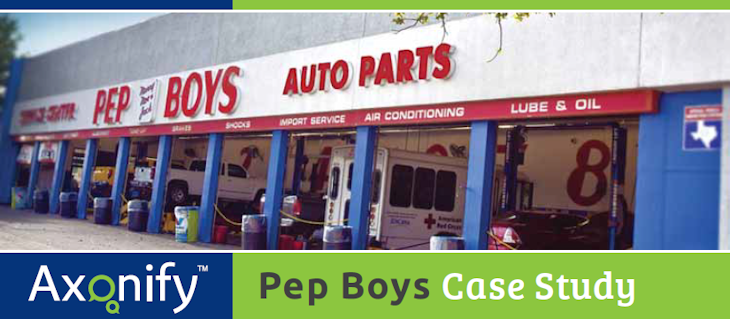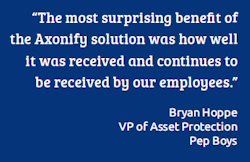|

Background
Pep Boys is a full-service automotive aftermarket retail
chain, headquartered in Philadelphia, PA. Operating over 700
stores do-it-yourselfer, do-it-for-me (service) and
buy-for-resale (sales to professional garages) who have come
to rely on Pep Boys for high-quality, name-brands, low
prices, convenience and un-matched service.
The Challenge
Pep Boys has always focused on delivering safety and loss
prevention messages down to the associate level. Similar to
other retail organizations, they had instituted a fairly
robust store level awareness program that included posters,
monthly manager-led meetings and when required, impromptu
huddles.
 Pep
Boys found that although they were doing a variety of things
around awareness training, they weren’t seeing the
reductions in inventory shrink and safety incidents that
they expected. Issues such as back injuries and internal
theft were still plaguing the organization. They often saw
their incident and shrink rates start to fall and then
quickly rise again with no discernable pattern. Pep
Boys found that although they were doing a variety of things
around awareness training, they weren’t seeing the
reductions in inventory shrink and safety incidents that
they expected. Issues such as back injuries and internal
theft were still plaguing the organization. They often saw
their incident and shrink rates start to fall and then
quickly rise again with no discernable pattern.
The team at Pep Boys hypothesized that their lack of
sustainable success was largely due to the fact that their
employees were not retaining and operationalizing their
learning. Associates would get the message and shortly
thereafter return to their prior habits with no long-term
change in behavior. With over 19,000 employees being
trained, it was virtually impossible to track who the
message was getting through to and who it wasn’t. It was
even more challenging to understand who was actually
applying learning to their job.
The Solution
In 2009, Pep Boys implemented the Axonify solution as part
of an overhaul to their loss prevention and safety awareness
programs. The goal was to reduce their shrink and safety
incident rates. Via the Axonify platform, associates now
receive daily reinforcement of monthly training they’ve
received through their LMS system. Employees answer
targeted, quick questions related to risk, loss prevention,
safety and operational policies and procedures that they
need to know. If they answer correctly, they play a slot
machine game titled “Quiz to Win” for a chance to win cash
prizes. If they demonstrate a knowledge at various intervals
until the employee demonstrates adequate information
retention. It takes 30 - 90 seconds a day and is
done either at the beginning of the associate’s shift or
during downtime throughout the day.
To Read More Click Here to Download the Case Study
|